Both the number of people who have jobs and those without have improved in July in the UK as the economic recovery continued, new figures show.
The Office for National Statistics (ONS) most recent data on UK jobs show the labour market continuing to recover.
The number of payroll employees showed another monthly increase, up 182,000 to 28.9 million in July 2021. However, it remains 201,000 below pre-coronavirus (COVID-19) pandemic levels.
In the latest period, the three months to June 2021 across the UK, there was a quarterly increase in the employment rate of 0.3 percentage points, to 75.1%, and a decrease in the unemployment rate of 0.2 percentage points, to 4.7%. The economic inactivity rate is down 0.2 percentage points on the previous quarter, to 21.1%.
In Scotland, the employment rate edged lower – 0.1% down to 74.2% in the quarter compared to the previous three months. The unemployment rate improvement was also less than compared to the UK at – 0.1 percentage points, while Scotland’s economic activity rate also rose, up 0.2 percentage points to 22.4%.
Scotland’s employment Minister Richard Lochhead said: “The Scottish Government will continue to do all we can to support employees and employers, but the UK Government must extend furlough for those that still need it.
“As we continue to move out of lockdown, we are pushing forward with an ambitious agenda of recovery and economic transformation that builds on the £3.7 billion in Scottish Government support to business since the start of the pandemic.”
ONS said the relaxation of many coronavirus restrictions, total hours worked increased on the quarter, however, it is still below pre-pandemic levels. The redundancy rate decreased on the quarter and has returned to pre-pandemic levels.
The positive jobs figures prompted a savings specialist at lender Scottish Friendly to warn that the Bank of England is now more likely to act on interest rates to cool the risk of rising inflation.
Kevin Brown said: “The post-pandemic jobs recovery continues to roll on and it now seems less likely that we will see significant redundancies being made from September onwards once the furlough scheme comes to end.
“Although there are fewer people in work than before Covid-19 struck in early 2020, job vacancies are at a record high and average weekly pay growth is rising faster than anticipated.
“However, workers enjoying higher pay could help to feed inflation in the coming months and that is likely to make the Bank of England nervous. If both continue in tandem, we could see the decision to raise interest rates made sooner rather than later.”
Suren Thiru, the British Chambers of Commerce (BCC) head of economics, said the market for jobs was “recovering strongly” as the boost to demand from the easing of restrictions helped drive higher payroll employment in July.
However he suggested the UK was not out of the woods yet and called on the government to extend training and support such as the Kickstart Scheme, which currently supports younger people, as well as ease restrictions on immigration to avoid unemployment “drift”.
He said: “Record vacancies confirm ongoing recruitment difficulties. Although the changes to self-isolation rules will help, with many firms facing a more deep-rooted squeeze on labour supply from the impact of Covid and Brexit, staff shortages may persistently weigh on economic activity.
“Although labour demand is currently robust, with firm’s finances still recovering from Covid and skills mismatches likely to limit the extent to which those seeking jobs after furlough can move into available roles, unemployment may still drift somewhat higher in the near term.
“Alongside rapid retraining opportunities, government should extend the Kickstart scheme into 2022 and expand it to enable older workers to gain new skills and experience. A more flexible immigration system is also needed to ensure that firms get access to the workers they need.”
